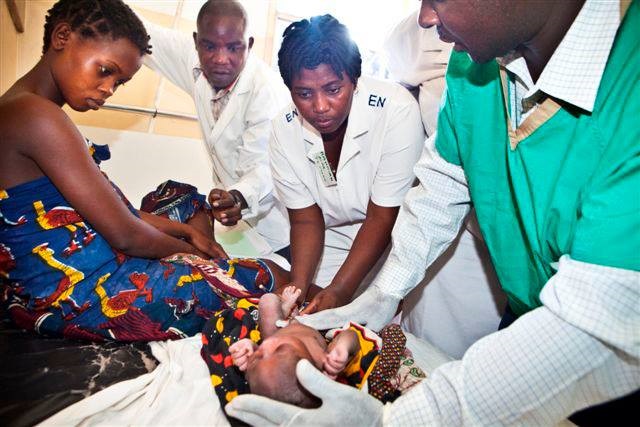Amana Hospital 4 Years Later
A New Reality for Mothers in Dar es Salaam
In February 2012, Kupona Board member Dr. Yoni Barnhard visited Amana Hospital in Dar es Salaam, and shared his experiences in a series of blog posts.
An American OBGYN, Dr. Barnhard found himself in an overcrowded, under-staffed, under-equipped delivery ward, and reported that, despite the desire to save their patients, the staff at Amana didn’t have the resources they needed to do so. The consequences were often tragic.
“Amana. Second largest district hospital in Dar es Salaam. 29,000 deliveries each year. Do the math. Teeming with births. Just 6 birthing beds. Not actually birthing beds. Metal tables with a hole at one end. Fresh blood dripping through. A bucket underneath. No full-time OBGYN. No full-time anesthesiologist. No air conditioning. 92 degrees outside. Hotter inside. This is where we start.”
Four years later, we’ve come a long way from where we started. Thanks to the tireless efforts of CCBRT’s Maternal and Newborn Healthcare team, in close partnership with the Government of Tanzania, Amana is unrecognizable. Kupona donors joined a committed network of supporters and partners including Vodafone Foundation, Global Affairs Canada (GAC – formerly DFATD), and CBM Australia. Today, we see expectant mothers are entering a very different hospital.
“The challenge is not practicing good obstetrics. The challenge is practicing better obstetrics with limited resources.”
Relieving the Pressure
Dar es Salaam’s healthcare system was designed to support a city of 750,000 people; hospitals and clinics now serve a population of over 4.4 million. Severe overcrowding hampers healthcare workers’ ability to give every patient the attention and quality of care they deserve. When Dr. Barnhard visited Amana 4 years ago, the hospital conducted 2,000 deliveries a month. He counted three nurses helping 41 women in labor.
Capacity building and training at smaller pre-referral healthcare facilities across the region means that families now place their trust in a greater number of facilities, decongesting wards at district and regional hospitals and relieving the pressure on healthcare teams. Today, Amana Hospital conducts 1,000 deliveries a month, giving staff more time to focus on each patient and respond efficiently to emergencies. In 2012, the labor wards were so crowded women were delivering five to a bed, or on the floor. Today, more women deliver one to a bed, though there are still space constraints in some of the wards.
“When it comes to saving a life, one can do far more with a single unit of blood than an ultrasound machine.”
The Tools to Save Lives
In 2012, Anna1, a 29-year-old pregnant woman, and mother of 6, arrived at Amana displaying severe preeclampsia symptoms. Her attending healthcare worker ran from room to room borrowing the medication needed to save her life. It wasn’t enough, and she died a few hours later. Anna’s death could have been prevented. Today, eclampsia and emergency kits are readily available, stocked with the medication and supplies needed to avoid preventable tragedies. Today, her 6 other children would still have a mother.
The leading cause of maternal death in Tanzania is post-partum hemorrhaging, and this is unlikely to change without addressing the severe shortages of safe blood supplies. In 2012, little was being done to overcome these challenges. In 2015, CCBRT’s Capacity Building Program began working with the Regional Health Management Team in Dar es Salaam to establish four satellite blood banks, increasing the availability of clean blood in the region. In addition, there are now two full-time OBGYNs at Amana, and training is available for surgical and medical management, giving staff the knowledge to confidently and competently save lives.
Lasting Change You Empowered
Improvements2 across the board at Amana mean that staff are equipped, trained, and available to tackle emergency cases, prevent birth injuries like obstetric fistula, and identify and refer newborns with impairments like cleft lip or clubfoot. A healthy child born to a healthy mother is less likely to be caught in the cycle of poverty, and more likely to pursue education and employment later in life.
In 2012, Amana Hospital’s delivery ward was a sea of women in all stages of labor, with an overwhelmed staff fighting an uphill battle to treat and save the patients in their charge. Today, with your support, we are seeing a new reality for the women of Tanzania, and in turn, for their children. There is still room for improvement and growth, particularly in early labor wards which are still crowded. There is also an emerging need for a space where mothers can nurse their sick newborns. However, CCBRT is ready to meet these challenge, spurred on by the success you’ve supported. Four years later, the future for Tanzanian families looks much brighter.
- Name changed to protect patient’s identity
- Following a recent assessment, Amana achieved 78% of quality standards for Basic Emergency Obstetric Care, compared to a baseline score of 9% in 2010.


